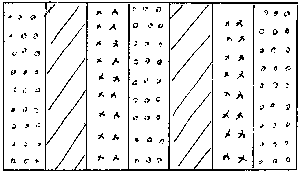Millennium Project
In the 16th century Deddington was described as "verye fertile, yieldinge greate store of corne and pasture". Ownership in the parish had long been concentrated in the hands of institutional landlords, largely the three "manors" (or estates) of Christ Church, Oxford, the Dean and Canons of Windsor, and the Duchy of Lancaster.
 The strips of cultivated land were held side by side, manor by manor. As late as 1777 one of the principal farms had its 80 acres scattered in 329 pieces of arable and 90 pieces of grass, although there had been some reorganisation and consolidation by then. Common land was subject to very complex rules and regulations, and in 1795 there were about 45 acres of common.
The strips of cultivated land were held side by side, manor by manor. As late as 1777 one of the principal farms had its 80 acres scattered in 329 pieces of arable and 90 pieces of grass, although there had been some reorganisation and consolidation by then. Common land was subject to very complex rules and regulations, and in 1795 there were about 45 acres of common.
The 16th and 17th centuries saw the emergence of several wealthy farming families in the village, amongst them the Appletrees, Bustards, Drapers, Lanes, Stilgoes and Churchills.
The 1808 enclosures - and after
By the late 18th century, Deddington's unenclosed farmland was regarded with disfavour, and arguably the most important change in the agricultural life of the parish since the early Middle Ages came with an Act of Parliament in 1808 allowing the parish to be enclosed. Strips of land were thrown together and redistributed as individual, consolidated farms. This map of Principal Inclosure Allotments (pdf) from 1808 shows how these farms were laid out may be magnified for more detail, courtesy of Victoria County History).
In the long run, enclosure led to an increase in farming efficiency, for example the putting in of new land drains, and certainly land values rose. There was not a great deal of difference in the number of farms after enclosure - by 1851 there were 13 of over 150 acres and seven others of over 40 acres. A century later there were 15 farms in the parish excluding minor holdings. (Today there are the nine farms shown on this annotated map (pdf)
Whereas many farmers did well out of enclosure, the loss of common rights seems to have put many smallholders and labourers at a disadvantage. Various attempts were made to help them find work, and in the 1820s the Vestry (the equivalent of today's Parish Council) ordered that men seeking agricultural work in the village should meet for hiring under the Town Hall at 6am on Mondays. This later increased to twice a week, and in the winter months of 1832 some 60 men were reporting daily for work. Part of the wages were paid by the parish, and those unemployed on the farms were put to work on roads and stone quarries or sent out as roundsmen.
It was in this period that the almshouses were built (1822) and a Coal Charity set up (1830s).
By 1914 almost two thirds of the land were under grass, with density of sheep and cattle high for the county. Principal crops were wheat and barley (and remained so for another 50 or so years) with 10 per cent of arable under oats.
In 1954, Christ Church Manor, which had greatly increased its holdings in the 19th and 20th centuries, comprised 1,604 acres and included 5 of the 15 large farms in the parish.
For further information about Deddington's farming history, visit: